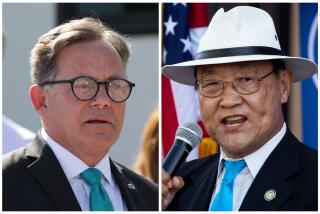3rd Union Decides to Abandon AFL-CIO
- Share via
The United Food and Commercial Workers International Union on Friday broke away from the AFL-CIO, becoming the third union to abandon the organization this week over disagreements about how to revive labor’s diminishing influence.
The 1.4-million-member UFCW represents workers in several industries, including retail, food processing and healthcare. More than half of its members work in supermarkets, and the union led a 4 1/2 -month strike and lockout that disrupted many Southern and Central California stores during late 2003 and early 2004.
Earlier this week, the 1.8-million-member Service Workers International Union and the 1.4-million-member International Teamsters Union left the AFL-CIO at the start of its convention in Chicago. The defections have deprived the AFL-CIO of nearly a third of its 13 million members and $28 million of its estimated $120-million annual budget.
Union membership in the U.S. has been declining for many years, and the breakaway unions want to commit more money to recruiting members. They complain that the AFL-CIO has spent too much money on backing political candidates, particularly Democrats.
UFCW President Joe Hansen said unions faced a hostile political and business climate because of their failure to organize.
“Tradition and past success are not sufficient to meet the new challenges,” Hansen wrote in a letter delivered to AFL-CIO President John J. Sweeney.
During the convention, Sweeney pledged to make changes to address the woes of organized labor, but the departing unions said those efforts were insufficient.
“We wanted change,” said Greg Conger, president of UFCW Local 324 in Orange County. “We need to take some of money we have been devoting to politics and build our membership.... That builds our strength again.”
The departure of the unions has frustrated labor federation officials.
“The UFCW leadership decision to leave the AFL-CIO, especially when working people are up against the most powerful, anti-worker corporate and governmental forces in 80 years, is a tragedy for working families,” said Lane Windham, a representative of the AFL-CIO. “Only union’s enemies win when unions split our strength.”
The UFCW’s Conger said leaders of the breakaway unions and their new organization, the Change to Win Coalition, expected to write a constitution and hold a convention within a few months.
At least three other unions may leave the AFL-CIO in coming weeks: Unite Here (garment, textile and hotel workers), the Laborers International of North America and the United Farm Workers.
The unions that split from the AFL-CIO now face the challenge of having to work together to maximize the power of labor, said Harley Shaiken, a professor at UC Berkeley who specializes in labor issues.
Their clearest difference is in how they want to a national labor organization to operate, Shaiken said. The breakaway unions favor a more authoritative federation that can compel member unions to act on its directives.
“That is at least in theory,” he said. “The test would be getting the Teamsters to do something they don’t want to do.”
The departure is part of the biggest rift in organized labor since 1938, when the CIO split from the AFL.
Supporters of the current breakup note that labor made big gains while the two groups competed.
When the groups merged to form the AFL-CIO in the 1950s, 1 of every 3 private-sector workers belonged to a labor union. Now, fewer than 8% of private-sector workers are unionized.
If the squabbling unions manage to achieve some of their goals, they may get back together, Shaiken said.
“We don’t know if we’re looking at an angry separation or a permanent divorce,” he said.
*
Times wire services were used in compiling this report.
More to Read
Inside the business of entertainment
The Wide Shot brings you news, analysis and insights on everything from streaming wars to production — and what it all means for the future.
You may occasionally receive promotional content from the Los Angeles Times.











